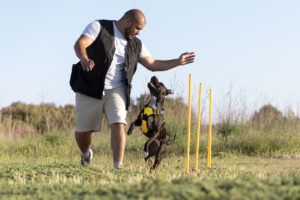We wish all of the best for our pets. Unfortunately, certain health issues, like hip dysplasia, can have a significant influence on our dog’s well-being and quality of life.
Hip dysplasia is a prevalent orthopedic condition that mostly affects big and gigantic breed dogs, but also small dogs with underdeveloped hips.
Fortunately, this article will go into the complexities of hip dysplasia, covering its causes, symptoms, and treatment options.
What is Hip Dysplasia in Dogs?
Hip dysplasia is the term used to describe an unusual growth or formation of the hip joint. The socket and ball can’t fit or grow properly in canines with hip dysplasia, so they grind or scratch instead of moving smoothly.
This instability may result in joint deterioration over time, producing discomfort, pain, and mobility difficulties in the afflicted dog.
Causes of Hip Dysplasia in Dogs
While the precise cause of hip dysplasia is unknown, many variables can also influence its development.
Genetics
Hip dysplasia can be inherited, which means that it is handed down from parents to the children. Large-breed pups have unique nutritional needs and demand food that has been particularly prepared for them.
Breeds vulnerable to this illness include Golden Retrievers and Rottweilers. Scientists from all around the world are undertaking dozens of investigations to identify the genes causing the disease.
The objective would be to find a genetic indicator for the condition that might be used to test dogs for the disease.
Environmental Factors
Hip dysplasia may be caused by environmental factors such as fast growth in puppies, poor nutrition, and excessive weight gain.
Caloric Intake
Excessive caloric intake, which causes rapid development and weight gain, as well as strenuous exercise, are indicators of risk for hip dysplasia in a dog who has a hereditary susceptibility.
This happens when the bone growth is faster than normal. Basically, the soft tissue development required for joint stability can’t keep up, resulting in joint laxity.
Symptoms of Hip Dysplasia in Dogs
Identifying hip dysplasia indications and symptoms is critical for early identification and appropriate intervention. Some dogs exhibit symptoms of hip dysplasia as early as four months of age.
There are a few signs that you should be aware of. These symptoms can vary based on the extent of the condition and the length of time the dog has had hip dysplasia.
Among the most prevalent symptoms are:
- Decreased range of motion
- Difficulty jumping or climbing
- Lameness in the hind end
- Decreased activity
- Thigh muscle mass loss
- Pain
Diagnosis and Treatment of Hip Dysplasia in Dogs
When you feel like your dog has hip dysplasia, it’s critical that you visit an animal veterinarian for an accurate diagnosis.
To determine the severity of the illness, the vet will do an extensive physical checkup and may request further testing such as X-rays as well as hip grading. In other circumstances, it’s up to the owners to notify vets when their pets are in pain.
Since inflammation caused by joint illness can be detected in the complete blood count, your dog’s physical checkup may involve blood tests.
The degree of the condition influences treatment choices. Below are several techniques that are commonly advised:
Weight Management
It is essential that you keep your dog’s healthy weight in order to reduce pressure on your dog’s hip joints. Consistent physical activity can assist to manage your dog’s weight because our dogs need good food and exercise just like us!
Medications
Hip dysplasia can cause discomfort and swelling. Luckily, nonsteroidal anti-inflammatory medicines (NSAIDs) can help relieve these. Examples include Carprofen, Meloxicam, Dericoxib, Firocoxib, and Grapiprant.
Also, vet may recommend supplements, too. Some of the most popular ones are glucosamine and chondroitin because they help preserve cartilage.
If your dog’s hip dysplasia does not appear severe, or if surgery is not an option for medical or economic motives, your vet may offer a nonsurgical treatment option.
Conclusion
If you have a dog of any age that is prone to hip dysplasia, see your veterinarian about the dangers and symptoms of hip dysplasia.
A veterinarian that understands your pet plus can evaluate your dog in person is perfectly suited to provide information and recommendations.
For the best results, aggressive physical therapy and regulated exercise to enhance hip range of motion are required. Some dogs may not improve for up to six weeks or more following surgery.
Want the best for your dog? Visit the PetFitness YouTube Channel or the PetFitness blog today!







